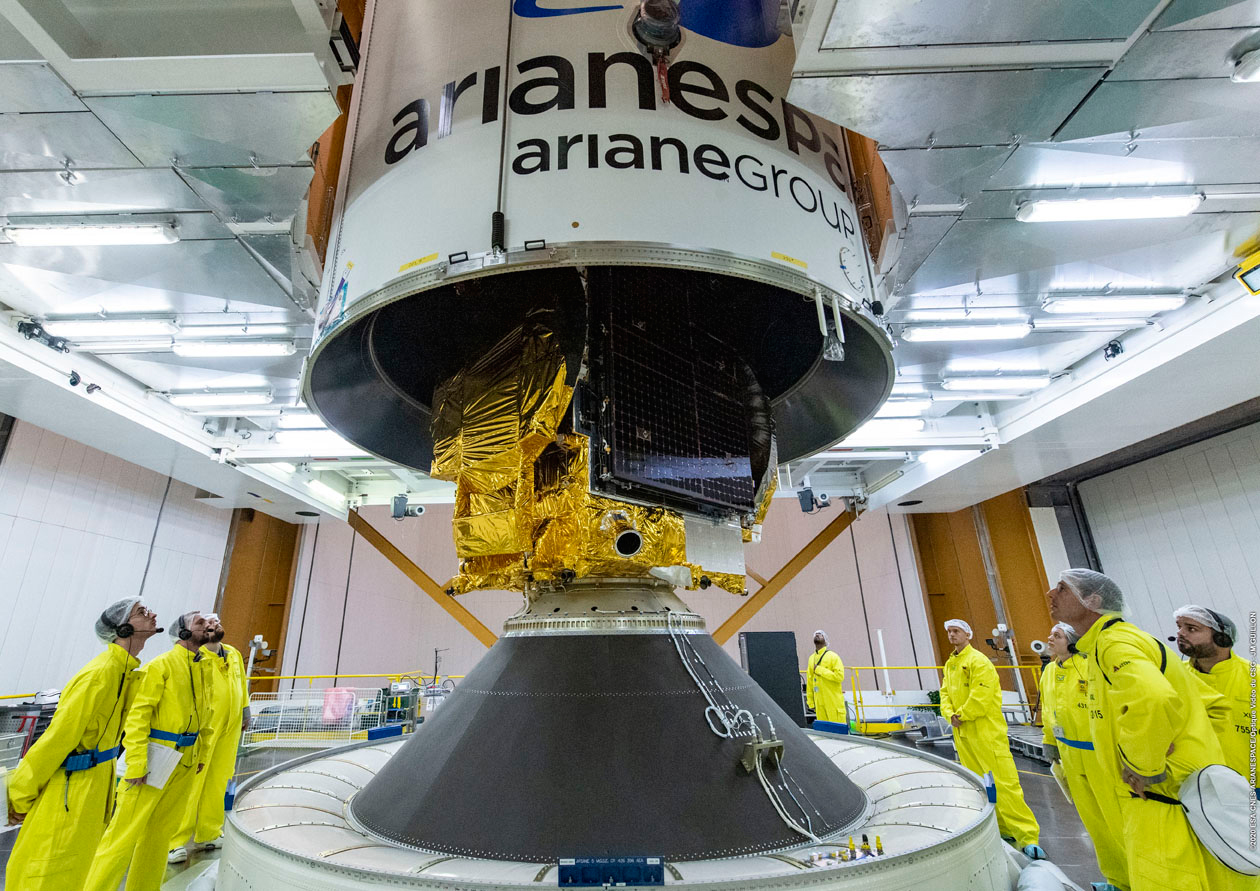An Ariane 5 rocket will launch 2 communications satellites today. How to watch live
Liftoff is scheduled for 4:05 p.m. EST (2105 GMT).
The European launch provider Arianespace will use an Ariane 5 rocket to launch two new communications satellites into orbit today (Jan. 16), and you can watch it live online.
For its first launch of the year, Arianespace will launch the Eutelsat Konnect satellite for the French telecommunications company Eutelsat and the GSAT-30 satellite for the Indian Space Research Organization (ISRO).
It will lift off from the Guiana Space Center near Kourou, French Guiana during a 1 hour and 55 minute-long launch window that opens at 4:05 p.m. EST (6:05 p.m. local time; 2105 GMT). You can watch the launch live here and on the Space.com homepage, courtesy of Arianespace, or directly via Arianespace's YouTube channel.
Video: Ariane 5 rocket will launch Eutelsat and Indian satellites
Related: Ariane 5 rocket launches satellites into orbit for Egypt, Inmarsat

The Eutelsat Konnect satellite is expected deploy into Earth's orbit 27 minutes and 30 seconds after liftoff, followed by GSAT-30 approximately 9 minutes later.
Eutelsat Konnect will join a fleet of nearly 40 Eutelsat satellites, which provide telecommunications services around the world, including television broadcasters, internet service providers, enterprises and government agencies.
Once in orbit, the satellite "will offer total capacity of 75 Gbps and by next autumn will allow the operator to provide internet access services for companies and individuals alike at up to 100 Mbps," Arianespace officials said in a mission description. "The satellite will help to fight against the digital divide by bringing broadband Internet across 40 countries in Africa and 15 countries across Europe."
Get the Space.com Newsletter
Breaking space news, the latest updates on rocket launches, skywatching events and more!
Eutelsat Konnect, which operates in the Ka-band, features an entirely electric propulsion system, and it is the first to use the all-electric Spacebus NEO platform built by Thales Alenia Space. It was developed by the European Space Agency and the French space agency, CNES.

The second payload, India's GSAT-30 communications satellite, will provide television, telecommunications and broadcasting services over India.
"By operating GSAT-30, ISRO will — once again — foster the use of space to help bridge the digital divide in the Indian subcontinent as part of its ambitious space program," Arianespace officials said. "These objectives are to develop India by focusing on all types of space applications, including navigation, Earth observation, telecommunications and broadcasts of educational programs, while pursuing science research and planetary exploration."
GSAT-30 will be positioned in a geostationary orbit at a longitude of 83 degrees East, where it will provide communications services in C- and Ku-band for at least 15 years, if all goes according to plan. It will replace the Insat 4A satellite, which launched in 2005 and is reaching the end of its lifetime.
To date, ISRO has launched 20 other GSAT satellites (not in the same order of their numbered titles), and 14 of them are currently in service. The last one to launch was GSAT-31, in February 2019. ISRO aims to launch at least three more GSATs this year.
- Space Launch Calendar 2020: Sky Events, Missions & More
- Europe's ArianeWorks Aims for Reusable Rockets (with a Very SpaceX Look)
- Vega Rocket Launch Failure in July Caused by Faulty Motor, Investigators Find
Email Hanneke Weitering at hweitering@space.com or follow her @hannekescience. Follow us on Twitter @Spacedotcom and on Facebook.

Join our Space Forums to keep talking space on the latest missions, night sky and more! And if you have a news tip, correction or comment, let us know at: community@space.com.

Hanneke Weitering is a multimedia journalist in the Pacific Northwest reporting on the future of aviation at FutureFlight.aero and Aviation International News and was previously the Editor for Spaceflight and Astronomy news here at Space.com. As an editor with over 10 years of experience in science journalism she has previously written for Scholastic Classroom Magazines, MedPage Today and The Joint Institute for Computational Sciences at Oak Ridge National Laboratory. After studying physics at the University of Tennessee in her hometown of Knoxville, she earned her graduate degree in Science, Health and Environmental Reporting (SHERP) from New York University. Hanneke joined the Space.com team in 2016 as a staff writer and producer, covering topics including spaceflight and astronomy. She currently lives in Seattle, home of the Space Needle, with her cat and two snakes. In her spare time, Hanneke enjoys exploring the Rocky Mountains, basking in nature and looking for dark skies to gaze at the cosmos.









